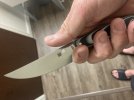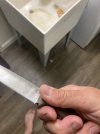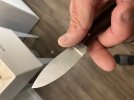deerrockknives
Only thing I’m sure about, I know nothing for sure
Knifemaker / Craftsman / Service Provider
- Joined
- Mar 2, 2020
- Messages
- 420
Hey folks,
Got a quick question I’ve been wondering for awhile and couldn’t seem to find it on the forums already.
I have wondered why on some knives, the handle scale stops far short of the finger guard. A good example of this is this spyderco bow river (see pic). To me, when holding a knife like this in a pinch grip (which you often do in a game type knife) your thumb and index finger are just pinching the blade portion and not the scale. Of course your remaining 3 fingers wrap around the scales. I guess I just wonder why not bring the scale much further up (see pic #2). Thanks for any insight.


Got a quick question I’ve been wondering for awhile and couldn’t seem to find it on the forums already.
I have wondered why on some knives, the handle scale stops far short of the finger guard. A good example of this is this spyderco bow river (see pic). To me, when holding a knife like this in a pinch grip (which you often do in a game type knife) your thumb and index finger are just pinching the blade portion and not the scale. Of course your remaining 3 fingers wrap around the scales. I guess I just wonder why not bring the scale much further up (see pic #2). Thanks for any insight.




